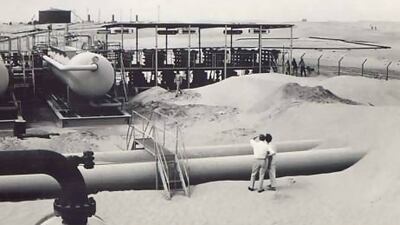Before the Second World War, partnerships between the resource-rich governments of this region and international oil companies (IOCs) were established through concessions. Abu Dhabi was no exception. It has two major concession agreements with IOCs, one for onshore oil operations and another for offshore. The concessions were lucrative deals for the IOCs as they received the property rights of massive untouched areas for which they had to give a fixed amount of money per tonne of oil produced.
After the Second World War, this type of agreement was difficult to sustain, as many newly independent countries were demanding a more equitable deal under the banner of a New International Economic Order through the newly established United Nations.
Angered by unexpected oil price cuts made by the IOCs in the late 1950s and emboldened by UN Resolution No 1803 "Permanent Sovereignty over Natural Resources" of 1962, many regional governments decided to nationalise their oil industries. Abu Dhabi did not follow suit. It honoured its initial agreements and consensually made gradual improvements in the agreements' terms.
Many factors determine the nature of partnerships or joint ventures between resource-rich countries and foreign investors. Unlike the concession agreements of the first half of the 20th century, the terms of the current agreements are determined mainly by the host governments.
This is no surprise considering the rapid evolution of the industry.
It is more competitive than ever. The footprint of easy-to-extract hydrocarbons and possible discovery has shrunk; indeed Abu Dhabi is one of the few places on earth where oil companies can still produce cheap oil. The number of industry players has considerably gone up. With restricted access to hydrocarbons, many of the IOCs are forced to push the exploration envelope and move into uncharted waters such as the Arctic and pre-salt reservoirs, causing increase in marginal barrel cost.
The oil majors are no longer the only industry giants, international national oil companies such as Statoil and CNPC are showing a competitive advantage in different technical areas of the industry, blurring the line between the IOCs and national oil companies (NOCs). According to some estimates, the IOCs controlled about 85 per cent of the oil reserves in 1970s, but now they control less than 10 per cent.
Moreover, oil industry projects are long-term and capital-intensive, requiring political stability, funds and technical capabilities. In the early decades of the previous century, the regional host countries did not have enough technical expertise or financial capability to run their oil industry. They had to partner with IOCs to exploit the natural resources.
However, the host countries' situation is different now. They have built NOCs with technical expertise and financial resources that can manage and self-fund projects of any size; Adnoc is a good example of that.
The legal and regulatory framework has matured over the past five decades. Abu Dhabi has always striven to solidify and streamline the operational practices and the corporate governance framework within which its hydrocarbons companies operate. This is evident in the evolution of the corporate governance of many of its joint ventures. Abu Dhabi's Law No 4 of 1976 and Law No 8 of 1978 are great governing components of the industry.
Certainty about the quality and quantity of the hydrocarbons is crucially important. Certainty has a considerable effect on estimations for resource availability, cost structure, production capacity and technical complexity. For instance, when Abu Dhabi's first concession was signed in 1939, not much was known about the geology and potential of the concession area. The government's capabilities were limited; hence it was logical to give the property rights to the IOCs, which were technologically and financially more advanced.
This has changed. Adnoc has become a giant NOC able to manage complex projects. Adnoc has a clear picture about Abu Dhabi's natural endowment. This allows it to do accurate economic analysis and equips it with the right information going into the negotiation room.
Among the resource-rich countries in the region, the UAE is the least reliant on hydrocarbons.
According to the Qatari bank QNB, the hydrocarbons industry accounted for an average of 34 per cent of the UAE's total economic output in 2007-11. The case was different before 2000 when the country was heavily dependent on hydrocarbons revenues for economic and social development. Now the country has diverse sources of revenues and it can afford to be patient with its natural resources.
The government has massive financial assets as a result of the current account and fiscal surpluses. In 2011, the current account surplus was 14 per cent of the GDP. This is an enviable position as it allows the country to make the best use of its natural resources without over-exhaustion.
The past partnerships between the resource-rich countries and IOCs were simple; the countries needed technical and financial help in developing resources and the IOCs needed access to resources. Today's partnerships are complicated, considering the involved and sometimes conflicting objectives of the resource-rich country and the oil companies. However, Abu Dhabi is in a perfect position to get the best economic value from its natural resources in its agreements with foreign oil companies.
Ebrahim Hashem is a senior adviser in business strategy and corporate governance at an Abu Dhabi-based company. Contact him via twitter @EbrahimHashem

